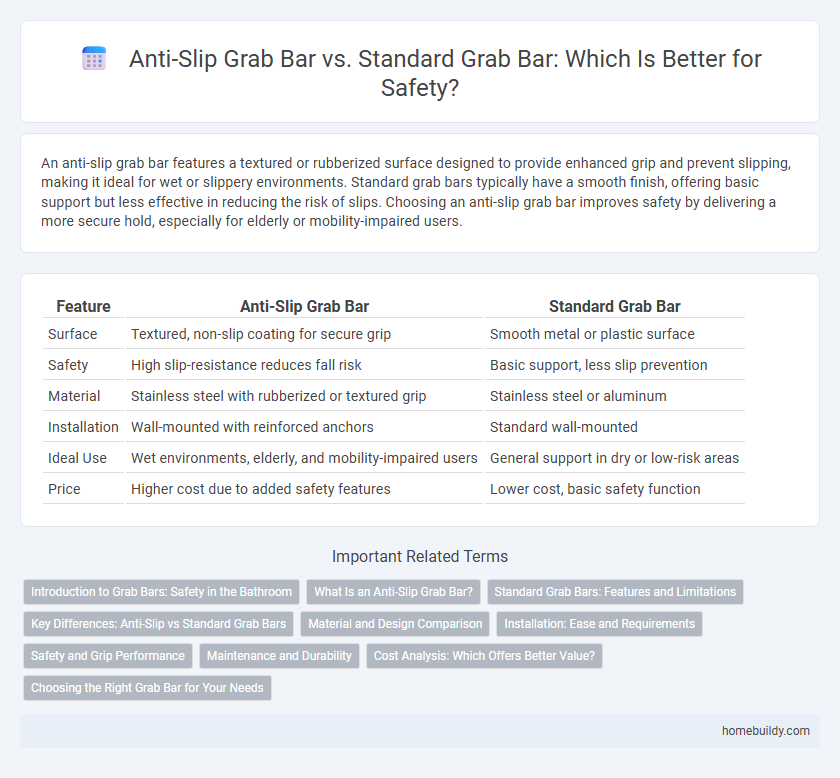An anti-slip grab bar features a textured or rubberized surface designed to provide enhanced grip and prevent slipping, making it ideal for wet or slippery environments. Standard grab bars typically have a smooth finish, offering basic support but less effective in reducing the risk of slips. Choosing an anti-slip grab bar improves safety by delivering a more secure hold, especially for elderly or mobility-impaired users.
Table of Comparison
| Feature | Anti-Slip Grab Bar | Standard Grab Bar |
|---|---|---|
| Surface | Textured, non-slip coating for secure grip | Smooth metal or plastic surface |
| Safety | High slip-resistance reduces fall risk | Basic support, less slip prevention |
| Material | Stainless steel with rubberized or textured grip | Stainless steel or aluminum |
| Installation | Wall-mounted with reinforced anchors | Standard wall-mounted |
| Ideal Use | Wet environments, elderly, and mobility-impaired users | General support in dry or low-risk areas |
| Price | Higher cost due to added safety features | Lower cost, basic safety function |
Introduction to Grab Bars: Safety in the Bathroom
Anti-slip grab bars enhance bathroom safety by featuring textured grips designed to prevent slipping, especially in wet conditions, unlike standard grab bars with smooth surfaces. These bars provide increased stability and confidence for users with limited mobility, reducing the risk of falls in showers and tubs. Prioritizing anti-slip materials and ergonomic design ensures optimal support and safety in high-moisture environments.
What Is an Anti-Slip Grab Bar?
An anti-slip grab bar features a textured or ribbed surface designed to provide enhanced grip and prevent slipping, especially in wet bathroom environments. Unlike standard grab bars, which have smooth surfaces, anti-slip grab bars reduce the risk of falls by ensuring secure hand placement even when hands are wet or soapy. Key materials often include stainless steel with a coated or patterned finish to maximize traction and durability.
Standard Grab Bars: Features and Limitations
Standard grab bars typically feature sturdy materials like stainless steel and a smooth, non-textured surface designed primarily for general support and stability. While effective in providing a secure handhold, they often lack specialized anti-slip textures or coatings, which can reduce grip security, especially in wet or soapy bathroom environments. Their limitation lies in the potential for slippage when hands are wet, making them less ideal for users requiring enhanced safety through improved traction.
Key Differences: Anti-Slip vs Standard Grab Bars
Anti-slip grab bars feature textured or rubberized coatings that enhance grip, significantly reducing the risk of slips and falls in wet bathroom environments compared to standard grab bars with smooth metal surfaces. These bars are specifically designed for safety in moisture-prone areas, providing superior traction even when hands are wet or soapy. Standard grab bars may offer sturdy support but lack specialized anti-slip materials, making them less effective for users requiring enhanced grip security.
Material and Design Comparison
Anti-slip grab bars typically feature textured or rubberized coatings made from materials like silicone or thermoplastic elastomers to enhance grip and reduce the risk of slipping, unlike standard grab bars that are often crafted from smooth stainless steel or aluminum. The design of anti-slip grab bars includes grooves, raised patterns, or non-slip sleeves specifically engineered to provide better hand traction in wet environments, whereas standard grab bars prioritize structural strength and sleek aesthetics. Material choices in anti-slip models focus on durability and water resistance with safety-enhancing textures, while standard grab bars emphasize corrosion resistance and minimalist design.
Installation: Ease and Requirements
Anti-slip grab bars often require specialized installation techniques, including secure wall anchors and potentially drilling into studs to ensure maximum stability and safety. Standard grab bars typically have simpler installation needs, relying on basic mounting hardware suitable for most bathroom walls. Choosing an anti-slip grab bar may involve additional tools and professional assistance to meet safety standards and comply with building codes.
Safety and Grip Performance
Anti-slip grab bars feature textured surfaces or coatings specifically engineered to enhance grip performance, reducing the risk of slips and falls in wet bathroom environments. Standard grab bars, typically smooth and made of stainless steel or aluminum, offer basic support but can become slippery when wet, compromising safety. Choosing anti-slip grab bars significantly improves user stability and confidence, particularly for elderly or mobility-impaired individuals, making them a superior option for bathroom safety.
Maintenance and Durability
Anti-slip bath grab bars feature textured surfaces or coatings that enhance grip and reduce the risk of slipping, while standard grab bars typically have smooth finishes. The anti-slip materials tend to require more frequent cleaning and inspection to maintain their grip effectiveness and prevent buildup of soap scum or mildew. Standard grab bars usually offer greater durability with less maintenance due to their simpler surfaces, but they provide less reliable traction in wet environments.
Cost Analysis: Which Offers Better Value?
Anti-slip grab bars typically cost 20-40% more than standard grab bars due to enhanced materials and textured surfaces designed to prevent slipping. While the initial investment is higher, anti-slip grab bars reduce the risk of bathroom falls, potentially lowering medical expenses and liability costs in the long term. Standard grab bars may save upfront installation costs but lack safety features that provide greater value in high-risk environments.
Choosing the Right Grab Bar for Your Needs
Anti-slip grab bars feature textured surfaces designed to enhance grip and prevent slips in wet bathroom environments, making them ideal for users with limited hand strength or mobility issues. Standard grab bars, typically smooth to the touch, provide basic support but may be less effective in preventing accidental slips during use. Selecting the right grab bar depends on individual safety requirements, bathroom design, and the user's mobility level.
anti-slip grab bar vs standard grab bar Infographic

 homebuildy.com
homebuildy.com